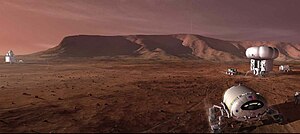Mars to Stay
[15][16] The proposal was to send a communication satellite and pathfinder lander to the planet by 2018 and, after several stages, land four humans on Mars for permanent settlement in 2027.
[29][30] In response to feedback following the EarthLight Institute's "Mars Colony 2030" project at NewSpace 2012 and the announcement of Mars One, Eric Machmer proposed conjunction-class missions be planned with a bias to stay (if low gravity, radiation, and other factors present no pressing health issues),[31][32] so that, if at the end of each 550-day period during a conjunction-class launch window no adverse health effects were observed, settlers would continue research and construction through another 550-day period.
Once settlers determine that humans can live on Mars without negative health effects, emergency return vehicles would be recycled into permanent research bases.
Subsequent missions therefore are assumed to become easier and safer to undertake, with the likelihood of back-up equipment being present if accidents in transit or landing occur.
Large subsurface, pressurized habitats would be the first step toward human settlement; as Dr. Robert Zubrin suggests in the first chapter of his book Mars Direct, these structures can be built as Roman-style atria in mountainsides or underground with easily produced Martian brick.
During and after this initial phase of habitat construction, hard-plastic radiation and abrasion-resistant geodesic domes could be deployed on the surface for eventual habitation and crop growth.
The longer-term work of terraforming Mars requires an initial phase of global warming to release atmosphere from the Martian regolith and to create a water-cycle.
First, it may contain concentrated supplies of metals equal to or of greater value than silver, which have not been subjected to millennia of human scavenging; it is suggested such ores may be sold on Earth for profit.
Secondly, the concentration of deuterium—an extremely expensive but essential fuel for the as-yet non-existent nuclear fusion power industry—is five times greater on Mars.
Humans emigrating to Mars, under this paradigm, are presumed to have an industry; it is assumed the planet will be a magnet for settlers as wage costs will be high.
Because of the labor shortage on Mars and its subsequent high pay-scale, Martian civilization and the value placed upon each individual's productivity is proposed as a future engine of both technological and social advancement.
Similarly, while zero-gravity presents challenges, near total recovery of musculature and immune system vitality is presumed by all Mars to Stay mission plans once settlers are on the Martian surface.
"It is ultimately much easier to journey to Mars from low Earth orbit than from the Moon and using the latter as a staging point is a pointless diversion of resources."
The agency's current Vision for Space Exploration will waste decades and hundreds of billions of dollars trying to reach the Moon by 2020—a glorified rehash of what we did 40 years ago.
[37] The passionate uproar among space exploration advocates—both favorable and critical—resulted in the Mars Artists Community creating several dozen more designs, with such slogans as, "Traitors Return to Earth" and "What Would Zheng He Do?"
It's possible ... relieving NASA of the need to send fuel and rocketry to blast humans off the Martian surface, which has slightly more than twice the gravity of the moon, would actually reduce costs by about a factor of 10, by some estimates.
[38]Hard Science Fiction writer Mike Brotherton has found "Mars to Stay" appealing for both economic and safety reasons, but more emphatically, as a fulfillment of the ultimate mandate by which "our manned space program is sold, at least philosophically and long-term, as a step to colonizing other worlds".
Two-thirds of the respondents to a poll on his website expressed interest in a one-way ticket to Mars "if mission parameters are well-defined" (not suicidal).
[39] In June 2010, Buzz Aldrin gave an interview to Vanity Fair in which he restated "Mars to Stay": Did the Pilgrims on the Mayflower sit around Plymouth Rock waiting for a return trip?
Learn first hand, in the final, visionary chapter about life in a Martian colony, and the adventures of a young woman, Aurora, who is born on Mars.
[7][45] Following a similar line of argument to Buzz Aldrin, Lawrence Krauss asks in an op-ed, "Why are we so interested in bringing the Mars astronauts home again?
"[45] While the idea of sending astronauts aloft never to return may be jarring upon first hearing, the rationale for one-way exploration and settlement trips has both historical and practical roots.
If it sounds unrealistic to suggest that astronauts would be willing to leave home never to return ... consider the results of several informal surveys I and several colleagues have conducted recently.
In an earlier 2004 op-ed for The New York Times, Paul Davies says motivation for the less expensive, permanent "one-way to stay option" arises from a theme common in "Mars to Stay" advocacy: "Mars is one of the few accessible places beyond Earth that could have sustained life [... and] alone among our sister planets, it is able to support a permanent human presence.
What's more, the president's suggestion of using the Moon as a base — a place to assemble equipment and produce fuel for a Mars mission less expensively — has the potential to turn into a costly sideshow.
[7]Davies argues that since "some people gleefully dice with death in the name of sport or adventure [and since] dangerous occupations that reduce life expectancy through exposure to hazardous conditions or substances are commonplace", we ought to not find the risks involved in a Mars to Stay architecture unusual.
"A century ago, explorers set out to trek across Antarctica in the full knowledge that they could die in the process, and that even if they succeeded their health[31] might be irreversibly harmed.


1989 painting by Les Bossinas of Lewis Research Center for NASA

1993 by John Frassanito and Associates for NASA
